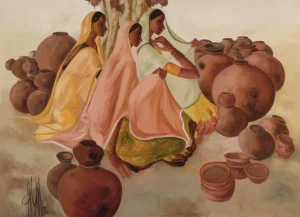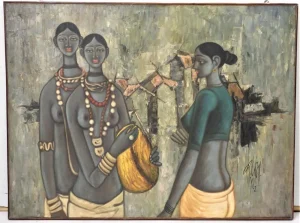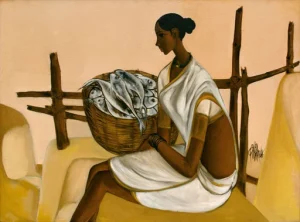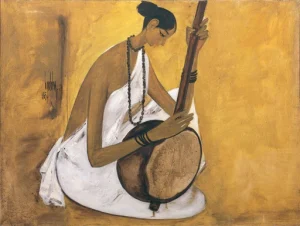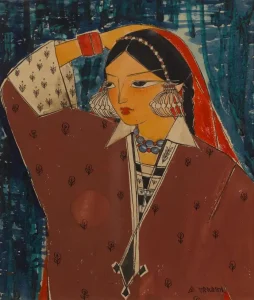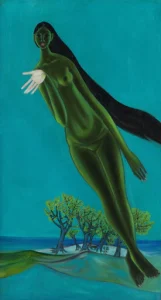Digvijay Nikam
One of India’s most important art collections was put together by the Indian airline company Air India. The ‘Maharaja Collection’ as it came to be called comprises over 4000 works of art including paintings, sculptures, and sketches by stalwarts of the Indian art scene post-independence like M. F. Hussain, V. S. Gaitonde, Anjolie Ela Menon. These works which were originally exhibited in the booking offices, office spaces, and printed on menu cards of the airline worldwide were aimed at presenting India – both past and modern. The provenance of this magnificent art collection owes its due to a woman painter who in 1956 walked into Air India’s art department and asked if the company would buy some of her paintings. The officials agreed and the purchase of her paintings marked the beginning of the collection. The artist was the now well-known B Prabha.
Courtesy of Tallenge Store.
Born in 1933, Badwelgar Prabha grew up in the small village of Bela, near Nagpur in Maharashtra. She studied at the Nagpur School of Art, before moving to Bombay on a scholarship, completing her Diploma in Painting and Mural Painting at the Sir J. J. School of Art in the year 1954-55. Inspired early on in her life by the Indian-Hungarian artist Amrita Sher-Gil, Prabha, like Sher-Gil, dreamt of being a renowned artist, taking her paintings across the world. By the time of her death (in 2001) her work had been shown in over 50 exhibitions in India and abroad and had found its way into important art collections.
Interestingly at her first exhibition when she was still a student at art school, three of her paintings were acquired by Homi J. Bhabha, the eminent nuclear scientist and patron of the arts, for the iconic art collection of the Tata Institute of Fundamental Research.
Courtesy of Invaluable.
Prabha after experimenting with several media and styles finally settled with oil as her preferred medium. Her signature style involving graceful, elongated figures evolved after her marriage to the artist and sculptor B. Vithal when she moved from a modern abstraction to more decorative figuration. Moved by the plight of rural women, Prabha’s protagonists, much like Amrita Sher-Gill, were usually women. She acknowledges in one of her interviews that “I have yet to see one happy woman” which is why she famously said, “It is my aim to paint the trauma and tragedy of women.”
To the contemporary reader, Prabha’s political stance and work might seem to pertain to a simple documentation of rural women, however, her works were a marker of a rebellious spirit in Post-Independent India when the country was just starting to acknowledge its patriarchal foundations. In addition to the women as her primary focus, her paintings also cover a wide range of subjects from landscape to social issues like droughts, hunger, and homelessness.
Courtesy of Tallenge store.
Prabha was a prolific artist who produced numerous paintings of women from diverse backgrounds captured in various postures in their daily lives performing certain activities. There are fisherwomen with their baskets of fish, women carrying or selling pots, talking to each other, tending their babies, playing cards, visiting the market, or simply gazing at the viewer. These paintings, among other things, invoke the amount of labour that women engage in every single day which goes unacknowledged in a society that overlooks domestic work and undermines the genuine labour of women.
Courtesy of Tallenge Store.
A significant section of her paintings depicts women figures playing musical instruments, especially the sitar and tanpura. These elegant figures seem to be engaged in a meditative act which is enhanced by their ascetic gaze, attire, and gestures. The focus and calmness that the Tanpura Player exhibits in her determination as well as an immersion in her act gestures towards completeness in her own being. This sense of completeness is acutely reflected in her oeuvre in general which is devoid of any male figures signalling an idea of womanhood and society where women work and are independent, find comfort in solitude as well as in the company of fellow women, their postures foregrounding their presence as humans with dignity, strength, and courage.
Courtesy of Sotheby’s.
In the mid-1960s Prabha travelled to Kashmir which led to a series of paintings documenting the valley and its people, particularly the women. Prabha’s artistic gaze focuses on ordinary people going about their daily occupations. There are boatmen, artisans and craftspeople, and agricultural labourers. Her painting titled Kashmiri Woman highlights the costume and the peculiar jewellery called Alcahor – a type of ear jewellery which rest over the ear and is connected by a chain running over the head.
Courtesy of Tallenge Store.
Alongside these concerns, many of her paintings seem to follow a strand of thinking and aesthetic practice that is yet to be explored and written about. This includes her fascination with painting women’s bodies in different colours like green, purple and especially blue. One of her paintings titled Woman (Green) is a good example of this where we find an elongated woman figure in green with a white palm floating in the air looking like a spectral presence in a dreamy landscape.
Other than this there are recurrent paintings that depict women, primarily Adivasi women, with birds where the bird doesn’t immediately symbolise freedom since it is juxtaposed with the unfeeling and silent faces of the woman figure. How might we think about these strands of Prabha’s artwork which presents a complicated yet exciting set of issues?
Prabha’s oeuvre is yet to receive enough public as well as scholarly attention for their socio-political concerns as well as aesthetics. In a world where women’s rights and independence have become much more thinkable and achievable, Prabha’s paintings serve as a reminder of those earliest and most significant attempts in art history to articulate these concerns.
References
- https://www.invaluable.com/artist/prabha-b-4y5jbvbhqq/sold-at-auction-prices/
- https://www.tallengestore.com/collections/b-prabha?page=3
- https://en.wikipedia.org/wiki/B._Prabha
- https://www.saffronart.com/artists/b-prabha
- https://www.theheritagelab.in/kashmir-paintings-bprabha/



